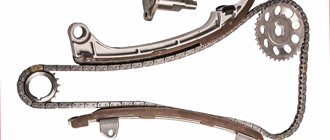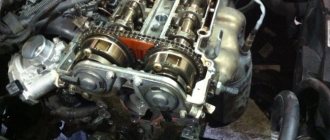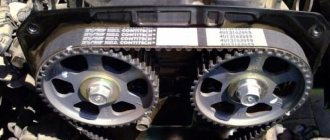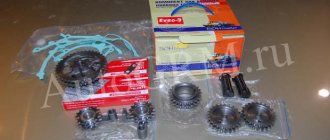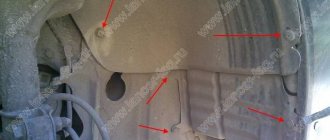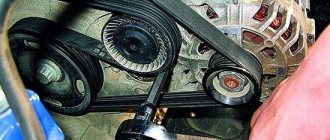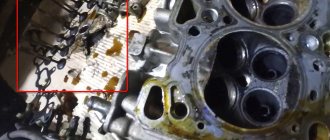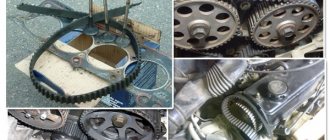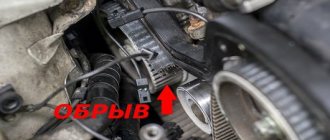Despite the fact that the car has long been firmly established in people’s lives, the discussed issues of the automotive topic do not change. People argue about what is better: gasoline or diesel, right-hand drive or left-hand drive, front-wheel drive or classic. Recently, drivers have been debating which is better, a timing chain or a timing belt. Modern engines can use both a timing chain and a timing belt. Moreover, the latter can be installed both on very small power units and powerful multi-liter engines.
What came first: chain or belt?
Any internal combustion engine in its design must have a mechanism that will ensure timely filling of the combustion chamber with the working mixture and removal of exhaust gases. This is done by the gas distribution mechanism, which is often called timing. Its design includes several parts, these are:
- Valve (inlet and outlet) that fill the combustion chamber and remove combustion products. They are installed in the cylinder head (cylinder head).
- The cylinder head provides space for installing one or two camshafts. This part is responsible for the correct distribution of working phases during engine operation and opens or closes the valve at the right time.
- A device that transmits rotational motion from the crankshaft to the camshaft and some other units, called a timing drive.
What is installed in a particular engine in the timing drive, a chain or a belt, or gears, depends on the preferences of the designers of the power unit. Gas distribution in engines has always been and will always be, and the timing mechanism drive has changed several times. The first samples of engines had a valve mechanism located in the cylinder block; they were driven by pushers from the crankshaft. After transferring them to the cylinder head, a drive for the timing mechanism was developed.
Internal combustion engine
Such engines (with overhead valves) made it possible to extract more power with an equal working volume of an internal combustion engine with a lower valve arrangement. Initially, timing drives began to use a chain. It could be single-row, double-row, or even three-row to increase reliability. To ensure the operation of the chain, a mechanism for tensioning it and a “calcifier” were additionally installed. The chain worked in conjunction with rollers, and later they were replaced by gears.
The first mention of the use of a timing belt in a timing drive appeared back in 1956. It was a Devin Sports Car made in America. About thirty years passed before this drive design was used in conventional cars. Currently, most of the motors produced have a timing belt, and a limited number of companies use the chain. Among them are BMW, Toyota, Mitsubishi and some others.
Some engines use a combined timing drive, in which a chain and a toothed belt operate simultaneously. To make it clear what is better in the timing mechanism drive, we should take a closer look at both designs of this mechanism. Each of them has its own advantages and disadvantages.
Evolution of the timing system
Chapter 1: Gears
The main purpose of timing chains or belts in internal combustion engines is to transport energy (torque) from the rotation of the crankshaft to the valve arrangement in the cylinder head, which is usually controlled by the camshaft (camshaft).
This problem is not that difficult to solve. The obvious solution is to use gears. It is with the help of them that it is easy to transmit torque in the lateral direction.
Here are the Volvo P1800S gears:
Yes, these are the gears of that 1966 Volvo P1800S that has traveled almost 5 million kilometers. The engine in this car has run more than 3 million kilometers without a single repair. Then expensive repairs were carried out, and the car again drove more than 1 million kilometers. And now about the sad thing.
Do you think it is profitable for automakers to produce cars that can serve the owner for a long period of time? After all, the longer the vehicle’s lifespan, the lower the automakers’ sales. Can you imagine how long cars would run today if they were all equipped with gears to transmit torque from the crankshaft to the camshaft? Imagine if you were the CEO of a company that sold a product that lasted 50 years instead of 10.
As far as we can tell, executives at major auto companies decided at one point in the history of the auto industry to design engines to reduce their lifespan. We don't know if this was done on purpose or out of necessity. But this does not change the essence.
Having started to design an engine with a shorter resource, car companies sought first and foremost for their own benefit, so that the cars in use in the world would end up in landfills faster, which would increase sales of new cars. But how to do this without complaints from car owners? Very simple. We need to come up with some smart new technology!
Chapter 1.5: Nylon Gears
The first solution to engine durability that we want to discuss is quite revealing - replacing metal gears with gears with nylon teeth that are mounted directly on the metal.
These are gears from a 1969 Chrysler 383 engine. It is important to know that these gears are more expensive than a regular metal gear mechanism.
This is because nylon is very expensive. As an alternative, you can, of course, use cheaper plastic. But plastic gears are actually more expensive than steel ones. After all, the production of plastic gears requires 30 times more material than the production of metal ones. This is the only way to ensure that a plastic gear can withstand the same load as a steel one.
What do you think is the justification that automakers have come up with for recently using plastic gears instead of steel ones? They attributed the replacement of steel gears to the need to make the engines quieter. However, this is a weak argument that only amateurs can believe. More on this below.
Chapter 2: Timing Chain
When some manufacturers began using nylon gears, one problem emerged: the gears were too weak. As a result, automakers began to receive a lot of criticism. The next energy transfer technology for engine synchronization was timing chains. This is a smarter way to reduce engine life without consumers complaining.
From an engineering point of view, the principle of operation of the timing chain in the gas distribution mechanism is based on the transmission of torque over long distances, as, for example, on this bicycle:
An important part of this mechanism is the rear spring, which helps keep the chain tensioned when changing gears on the bike. After all, when the chain jumps to another sprocket, the length of its straight segment changes. If there were no special mechanism, then when changing gears the chain on the bicycle would sag or even fly off.
This problem does not exist in the car. But cars have their own problems. For example, a timing chain wears out over time (and when compared to toothed gears, the chain wears out very, very quickly). This results in an increase in effective chain length over time. Therefore, automakers have equipped the timing chain with a tensioner to eliminate slack. Well, here's yet more evidence that automakers have intentionally shortened the life of engine components by switching to a timing chain.
In principle, there was no need to use a chain. Moreover, the torque from the crankshaft to the camshaft must be transmitted over short distances. But no. Automakers deliberately decided to equip all engines with a timing chain, which wears out very quickly compared to gears.
This certainly solved the durability problems of the engines of the 60s.
Here are two solutions for timing chain drive:
In the left picture you can see the engine equipped with long valve lifters (OHV diagram). This motor uses a small chain. On the right you see an OHC or DOHC engine that uses a long chain. The design on the left is designed to last longer. Also, the motor design on the left is cheaper and lighter. The longer chains used in OHC engines will wear and stretch more over time. The worst thing is when in engines with two chains, one chain wears out faster than the other. In this case, the more worn chain tensioner will impair the ideal synchronization of the motor.
But many automakers use a variety of different technologies to prevent such asymmetries in engine timing as a result of chain wear or stretching.
Some engines have variable valve timing systems, such as VTECH or VANOS. In such motors, the chain tensioner is connected to the timing advance device. On such motors, if the chain sag due to wear, it automatically advances slightly by several links.
But in all these examples, when using a timing chain, we do not see systems that prevent rapid wear of the chains. Instead of figuring out how to increase the life of timing chains, automakers have done everything to ensure that a highly tensioned chain experiences maximum mechanical friction. This means that over time, not only the tension of the chain is disrupted, which leads to its wear, but also the chain tensioners also wear out.
Chapter 3: Timing Belts
Can the problem of engine durability be solved with belts? If you're an engineer at a car company tasked with figuring out how to shorten the life of engines, you certainly won't stop at timing chains. You will definitely come up with something else, happily informing your managers that timing chains should be used instead of timing belts.
This is exactly what happened in the history of the auto industry. Timing belts were the next step in the conspiracy against car owners who dream of owning one car all their lives. Timing belts have replaced chains in many cars.
Timing belts appeared on the scene back in 1962. But in the early days, belts did not become so popular because in those years there was no technology capable of producing strong belts. And it was all about the rubber from which the first belts were made. It is known that rubber ages quickly at high temperatures.
As a result, the first timing belts did not last long and broke, which often led to significant engine damage. Then belts became more reliable, and automakers began eliminating chains, also claiming they were necessary to reduce engine noise. But, despite the production technology of timing belts, they are still inferior in service life to timing chains. Automakers have made it so that car owners come for maintenance more often to replace the timing belt (which costs a lot of money).
In modern cars, timing belts last longer than in older cars. In some cars, the timing belt needs to be changed every 100-150 thousand km, while more recently in some cars, automakers recommended changing the belt every 30-45 thousand km.
But this does not mean that timing belts now have an advantage over the chain. This also doesn't mean you should rush out and buy cars with only a timing chain. It is not that simple.
Chapter 4: Plastic Guide Chains
The next solution to the problem of automobile durability was for automakers to switch from using conventional chains to chains that use curved plastic guides. This plastic falls apart over time. But don't be surprised. This was originally designed so that these plastic guides would fail after a certain mileage of the car.
Plus, such modern motors use indirect long chains. That is, the principle is used, as in this 10-speed bicycle:
From an engineering point of view, in order to effectively transmit torque along a long chain, an additional gear is needed. But in the above example in the video, the chain in modern engines is bent and constantly interacts not with the gear, as it should, but with a piece of PLASTIC!
What is more expensive - a timing chain or a timing belt?
So we looked at how automakers moved from gears to timing chains and then to timing belts, and now they've decided to use chains again. Now it remains to figure out what is cheaper to maintain - a car with a timing belt or a chain? Of course, it all depends on the make and model of the particular car. But in general, everything turns out to be roughly the same, no matter how strange it may seem at first.
A timing belt, of course, costs less than a chain. But once you get the pulleys and everything else for the timing belt, the cost of replacing the timing belt and drive rollers will be roughly comparable to the cost of replacing the timing chain.
If we talk about old used cars, then, of course, it is preferable to buy a car with a classic chain, which is an ancient technology that has stood the test of time. If we talk about new modern cars, then today it is better to purchase cars with a timing belt, since the new chain timing technologies, which are gaining popularity again, are imperfect and less reliable than the old classic timing chain systems.
But with cars that use timing belts, you need to be careful, since belts tend to break unexpectedly due to wear or manufacturing defects. In this case, many engines will fail due to the fact that the engine valves meet the pistons.
Chapter 5: Variety is the spice of life
We have only scratched the surface of what is happening with the evolution of cars. Everything is actually more complicated. Here you can read why modern engines are much worse than old ones.
There are already a lot of questions for car manufacturers. For example, why do Mercedes E-Class cars produced for the German taxi fleet easily travel 500 thousand km, while conventional versions cannot always reach such a mileage without repairs? Or why modern trucks, just like older ones, can still easily travel more than 1-2 million kilometers without repair, despite the fact that truck engines have a higher compression ratio and torque?
Or, for example, why do modern oxygen sensors fail much faster than in older cars? Or why did automakers begin to use plastic parts instead of metal ones in the design of many components, which ultimately led to a significant reduction in the service life of vehicles? And there are thousands of such questions.
Typically, manufacturers answer all questions simply: replacing metal parts with plastic ones is necessary to reduce the weight of cars. But wait, is there no aluminum in the world? But no, automakers continue to deteriorate cars, making everything easier with plastic.
In fact, an entire textbook would need to be written to list all the parts that have deteriorated in modern cars.
Valve train chain
Most of the “old” domestic and imported car models have a timing chain in the timing drive. Experienced drivers are accustomed to it and treat innovations in the form of a timing belt with some caution. They are very enthusiastic about proving to the younger generation the feasibility of using a metal chain in the drive. A modern chain drive is highly reliable and efficient.
Advantages of chain drive
The main advantages of this factor include the following factors:
- high reliability and durability of the mechanism;
- no dependence on temperature differences;
- small amount of maintenance work.
Timing chain
Having a long service life, the chain does not require special maintenance costs. Its resource especially depends on the operating conditions of the power unit and the quality of the consumables used. If all engine maintenance recommendations are followed, the chain can last more than 200 thousand kilometers.
Disadvantages of the chain
Unfortunately, there are more of them, but they cannot surpass the advantages of such a design; the disadvantages of such a design are:
- The design is a complex mechanism. To replace a worn part or check the technical condition of the drive, you have to perform several disassembly operations.
- Increase in engine weight.
- Increased noise during engine operation.
- Expensive cost of repair and maintenance of the chain drive.
Are the valves bending?
It is impossible to say unequivocally that this is impossible. A break in the motor chain in the timing drive is a very rare phenomenon, but it still occurs sometimes. If such a problem occurs with the chain. The meeting of valves with pistons is inevitable, they will be bent, and the piston head can be severely damaged. This can be avoided if the engine of the VAZ 2101–2107 family is equipped with pistons from the VAZ 2105, which have recesses in the piston heads.
Features of the timing chain design.
While almost all car enthusiasts are familiar with a belt drive, the use of a chain as a timing drive part is much less common, which means that not everyone has encountered it. Most older engines used double-row chains that were virtually impossible to break. It rests on gears and drives the gas distribution mechanism, synchronizing the work with the crankshaft flywheel. Nowadays, single-row chains are used, reminiscent of a regular bicycle chain. During operation, it receives constant oil lubrication, which not only facilitates operation, but also reduces its heating. Due to the need to install an additional lubricant bath, the block and cylinder head need to be seriously lengthened, which negatively affects the engine size and weight.
Advantages and disadvantages of using a chain in a gas distribution mechanism.
The main advantage of a timing chain transmission is an increased service life, which is absolutely independent of vehicle operating factors. The chains are not afraid of either frost or heat. Tolerates rain and snow calmly. These factors do not have any significant influence. Thanks to the use of chains, it is possible to adjust the operating valve timing much more accurately. The chain stretches much more slowly, and throughout almost its entire service life there will be no violation of the set settings and, as a result, loss of power from the power unit. Let us also highlight the fact that engines with a chain drive are able to withstand more serious overloads than motors with a belt.
One of the disadvantages of timing chains is the high cost of replacement. The chain can withstand the guaranteed service life, but at the end of its service life, the chain drive has to be replaced, which requires paying an amount almost twice as much as when replacing a timing belt. You can also read the article about replacing the chain on a Peugeot with an EP6 engine
Timing belt
The timing belt drive has many positive aspects, thanks to which it has become popular today in the designs of modern power units. Such a drive has to be serviced more often.
Replacement is usually made at 50–60 thousand kilometers. It is not difficult to replace a belt that has served its life, you can do it yourself. Belt breakage rarely occurs. The most common problem is the cutting of teeth in this product.
Benefits of the belt
These include the following factors:
- This drive is simple in design and does not require lubrication during operation. There is no channel for the chain in the engine, which reduces the overall weight of the machine’s power unit.
- There is no noise when the motor is running.
- Low cost of repair or maintenance of the timing mechanism.
Timing belt
The length of the engine becomes shorter, which in cars with front-wheel drive takes up space across the body.
Disadvantages of the belt
There are no mechanisms that do not have shortcomings, this fully applies to the timing belt transmission of the timing mechanism. Such a drive is very vulnerable to many factors during machine operation. These include the ingress of water or motor oil into the work area and a large temperature difference. It is especially sensitive to low temperatures. The reliability of the belt drive depends not only on the mileage of the car, but also on the age of the timing belt.
The mileage may be low, and the car has been sitting for several years without driving, so the belt must be replaced. Engines with such timing mechanisms are afraid of sudden engine cranking, as this can cause the belt to slip. Today, most engines have phase shifters; for them, the risk of engine oil getting into the operating area of the timing drive increases.
What's wrong with the valves?
The use of gasoline with a high octane number as fuel requires a strong increase in the compression ratio of the working mixture at the top dead center of the piston stroke. This is achieved by reducing the volume of the combustion chamber. If for some reason the valve remains motionless, it encounters a moving piston.
On VAZ 2105 cars, pistons with grooves are installed, which eliminates the possibility of encountering the valve. The same principle is used on VAZ 21083 engines with a displacement of 1500 cm3. This problem can arise when the belt breaks or its teeth are cut off.
Let's sum it up
What should you choose? If you compare all the characteristics of the chain and belt, weigh all the pros and cons, it will ultimately turn out that these two mechanisms contrast the stability and quality of the belt resource and the affordable price for its replacement, and a chain that is more resistant to adverse effects, the replacement of which quite expensive, and operation largely depends on lubrication and operating modes of the motor.
Car manufacturers are constantly searching for the right solution. The two sets of characteristics compete with each other, so there is no advantage on one side. Opinions usually differ. Volkswagen engines in the most affordable price segment most often use a belt rather than an unsuccessful chain. Even the most powerful engines of the German automaker also have belts.
Medium-sized EA888 engines still use a chain mechanism, which works quite successfully there. Sometimes Volkswagen masters even combined two mechanisms. In this case, a chain was used to synchronize the rotation of two camshafts, and one of them was driven by a belt.
Opel, along with General Motors, now use timing chain drive for all engines, including the smallest ones. Even despite only the relative reliability of the chain drive of the mid-size engine family. However, the manufacturer did not have any problems with the belts.
The BMW company uses only chains on its famous engines, but the success of this event is very erratic. Sometimes BMW resorts to frankly unsuccessful lightweight designs, and sometimes a good chain can last even longer than the engine itself. With a timing belt, the German flagship produced an excellent M40 engine whose reliability was never in question.
To summarize, we can say that it is impossible to accurately predict which type of timing belt will be more reliable. To compare, you need to refer to specific examples; in addition, it is important to take into account the likelihood of design errors and the operating conditions of the motor. The belt can really be reliable, so there is no need to be afraid of using it. Although the chains are reliable, if they fail, the price for replacement will unpleasantly surprise you.
As an addition, we suggest watching a detailed video about replacing the timing belt on a VAZ 2112 car:
You can also read on this topic:
10 Best Car Battery Chargers
Engine additives must be used carefully
A new car under 350,000 rubles is rare
The instrument panel of the VAZ 2114 looks great and hardly breaks
The engine lubrication system allows you to increase the service life of the car
Share on social networks
Alexander Stepanoff April 3, 2015
Published in: Useful tips and car devices
Tags: How a car works, Tips for motorists
Which repair is more expensive?
The cost of replacing a timing belt in a timing mechanism in some cases may be slightly higher than its chain counterpart, since the tension roller and coolant pump pump are usually replaced along with it. The cost of replacing a chain is affected by the degree of preparatory work for such an operation.
On some engines, it is necessary to dismantle a large number of parts on the engine and in the engine compartment. There are car models where you have to completely dismantle the engine to replace the chain.
What to choose
It is quite difficult to determine which option will be better for the owner. It all depends on the choice of engine or car model. You can find examples of excellent performance in timing mechanisms of both chains and timing belts. Thus, BMW for a long period used only chains in mechanisms. Today it produces a number of motors with timing belts.
Regardless of which type of timing gear the driver prefers, the mechanism should be serviced on time and with high quality, and the recommended consumables should be used, then problems with the serviceability of this unit will bypass it.
